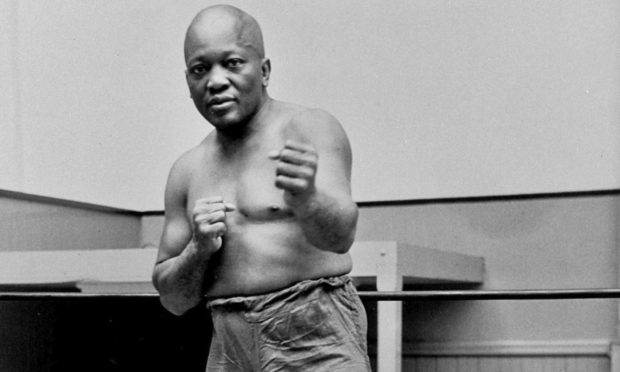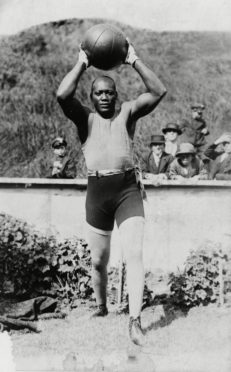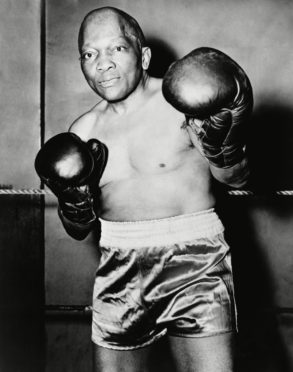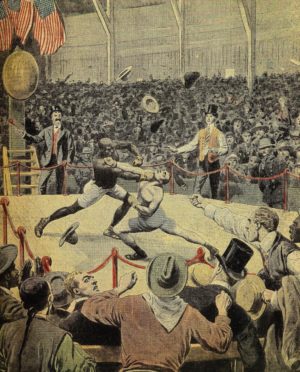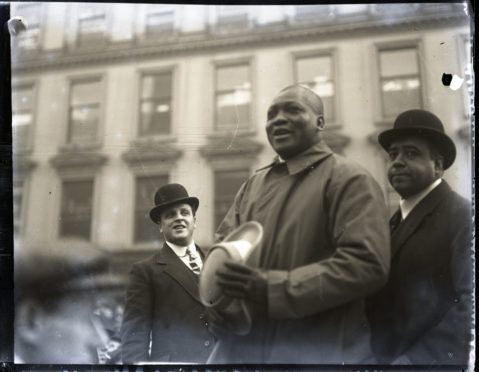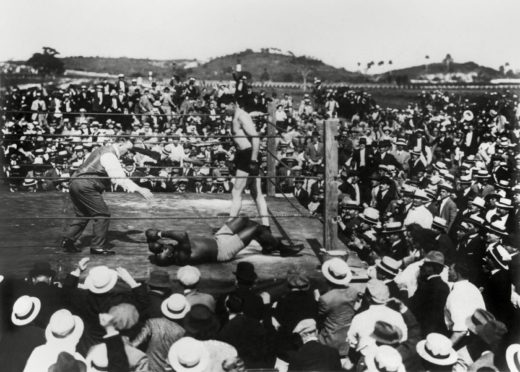Heavyweight boxer Jack Johnson fought off a cold to take the city by storm when he made a triumphant return to Dundee in January 1916.
Johnson, known as the Galveston Giant, became the first black boxer to win the world heavyweight title, paving the way for the likes of Joe Louis, Muhammad Ali and Mike Tyson.
The 38-year-old was no longer the champion and was now doing a revue entitled Seconds Out which attracted enormous audiences at the King’s Theatre.
Freemason
He was back in the city for the first time since 1911 when he became a Freemason, donning his apron at Forfar and Kincardine, No. 225 Lodge.
A huge crowd arrived to watch his white sports car arrive at the King’s Theatre which was to set the pattern for the whole week.
Thousands of people followed him everywhere and there has been nothing to match the hero worship which swept through Dundee for Johnson.
Queues formed every morning to make certain of seats for the first house matinee and by late afternoon crowds were gathering in the Cowgate for the evening show.
The reviews for the show were good.
Johnson was down to perform a song on the opening night but a cold prevented him from showing off his vocal powers and he delivered a talk on boxing instead.
Johnson’s wife Lucille played the role of Lady Thurlow and the feature of her performance was an exhibition of the oyster dance with a male partner.
A Courier reviewer said the climax of the opening night was Johnson putting his gloves on and sparring with a number of budding pugilists from the audience.
“Three soldiers and a sailor supplied the opposition at the first evening performances, and while none of them succeeded in inflicting any punishment on Johnson, by their energy and lightning footwork they seemed anxious to make an impression, but the great man was kind to them and permitted them to enjoy to the full the historic incident in their respective careers of having ‘fought’ against Jack Johnson, who seemed to enjoy himself as much as anyone in the audience.
“Apart from the personalities of Mr and Mrs Jack Johnson, the revue is like most other revues – a happy jingle of singing, dancing, and humour, strung together without much regard to plot or sequence of narrative.”
Tommy Dodds
According to another report, Johnson did a bit of sparring and then ‘fought’ a local character called Tommy Dodds who stood just four feet tall.
Dodds went on to knock down the champ by hitting him on the knee.
Also on the bill were circus acts including elephants.
The son of former slaves, Johnson was born in Galveston, Texas, in 1878.
He won the unofficial black heavyweight championship in 1903 with a 20-round decision over Denver Ed Martin.
Because of his race, however, Johnson was repeatedly denied the chance to fight James Jeffries for the heavyweight championship.
Johnson finally got his chance on Boxing Day in 1908 when he hammered Canadian Tommy Burns in the 14th round in Australia.
He became a Freemason in Dundee three years later when army officer Sydney McLaglen told Johnson about his masonic lodge during a fight in Newcastle.
McLaglen was due to travel to Dundee to receive the second degree and Johnson asked if he could go with him because he always wanted to join the lodge.
During the closing part of the initiation ceremony a telegram was dispatched to Dundee from the Grand Lodge of Scotland demanding that the proceedings cease immediately.
However, the master decided that it was too late and continued with the ceremony regardless.
After the ceremony a group of Johnson’s admirers carried him shoulder high through the hall to the taxi which was waiting outside.
Suspension
Johnson’s initiation cost the master at the time a two-year suspension from the craft.
Two other past masters received one-year suspensions and the lodge had its charter lifted for 18 months.
This was because its members refused to bow to pressure from the American Grand Lodge and the Grand Lodge of Scotland to send him back the three guineas he had paid to become a member.
Most Grand Lodges in the USA threatened to withdraw their Scottish Grand Lodge representation and this was why the Grand Lodge had attempted to halt Johnson’s initiation ceremony.
In 1913 Johnson was convicted of violating the Mann Act for bringing his white girlfriend Lucille across state lines before their marriage.
Sentenced to prison, he fled to Europe, remaining there as a fugitive for seven years.
He continued to fight overseas, including two defences of the world title in Paris before he lost to Jess Willard in 1915.
Willard was a working cowboy from Kansas who knocked out Johnson in the 26th round of the scheduled 45 round fight at Oriental Park Racetrack in Havana, Cuba.
People’s Journal interview
Johnson spoke to the People’s Journal during his run at the King’s Theatre in Dundee in 1916 and claimed he had lost the fight against Willard on purpose.
No hard evidence has ever surfaced, but Johnson said he threw the match in exchange for a pledge that he could return to the US and avoid criminal charges.
“Yes I’m glad I lost the title of heavyweight champion of the world,” he said.
“I don’t want to be champion of the world.
“If I won the title again tomorrow I would willingly hand it to the first man who passed me on the street.
“I say now that there is not a man breathing whom I think I could not beat.
“I am not speaking disrespectfully of Willard because I think he is a great fellow – as far as a man is concerned, but if he were as good a boxer as he is a nice fellow, he would be a great fighter.
“My fight with Willard was a financial proposition.
“You may have heard how I was persecuted after becoming champion.
“Yes, I suffered some at the hands of the ‘dandy’ people of America, because they could not find a white man to beat me.
“Well, they promised me that if I would consent to be defeated by Willard I would no longer be molested and would enjoy the freedom any other man would.
“It sounded very attractive but they played the ‘double cross’ on me.
“I lost.”
City of Dundee
Johnson was asked if he would fight Willard again.
“I have as much chance of fighting Willard again as I have of carrying the city of Dundee on my back,” he said.
He returned to the USA in 1920 and served his sentence.
Johnson never again fought for the world title.
After his release, he fought sporadically until he retired at the age of 53, finishing with a career record of 71 wins, 11 losses and 11 draws.
He continued to fight after retiring in what was known as “cellar” fighting, where the bouts, unadvertised, were fought for private audiences.
Johnson made his final ring appearance aged 67 in 1945, fighting three one-minute exhibition rounds against two opponents, Joe Jeanette and John Ballcort, in a benefit fight card for US War Bonds.
He died as a result of a traffic collision in in 1946 in Raleigh, North Carolina, at the age of 68.
Johnson had stopped to eat at a diner and the owner made him sit in the back, out of sight from white patrons.
Johnson drove away incensed and lost control around a sharp curve and crashed into a telephone pole.
Twenty years later, Johnson was inducted into the International Boxing Hall of Fame and in May 2018 he was granted a posthumous pardon by President Donald Trump.
